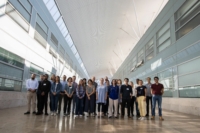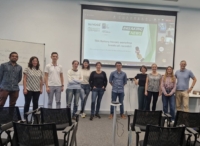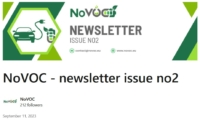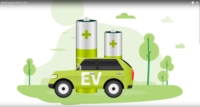Discover here the latest news for the NoVOC project
Battery heroes video published
The official video of the Battery heroes cluster has been published The Battery Heroes is a cluster of six European Union Horizon Europe funded projects dealing with the sustainable production of lithium-ion batteries. The initial four of these projects have produced a video together. Learn more about them via their respective websites: NoVOC greenSPEED GigaGreen BatWoman Access the video
Videos of NoVOC work package leaders published
Videos of NoVOC work package leaders published While we were in beautiful San Sebastián, in Spain for our General Assembly meeting, we shot videos of our WP leaders, presenting themselves, their institutions and their roles in the project. Meet Mattia Giuliano, from Stellantis CRF in Turino, Italy, Guiomar Hernandez from Upsala University in Sweden, Syed Zaidi from Customcells Itzehoe, Germany, Nicolas Bucher from Varta MicroBattery GmbH in Ellwangen, Germany, Romain Chane Ki Chin from SNAM in France, and Nicole Schmidt, from EUTEMA Research Services GmbH in Vienna, Austria. Access the videos
NoVOC third newsletter available
NoVOC third newsletter published The 3rd issue of our NoVOC newsletter has recently been published on our LinkedIn channel!! 🗞️🔋 On a bi-annual basis, we share insights into our daily collaboration within our 17 partners Horizon Europe funded project. Here’s what you’ll find in this issue: 1. What we did over the last couple of months - latest updates on the project activities 2. Who we (still) collaborate with- meet the "Battery heroes 2.0" 3. Where you find us - future events and more Learn about our results, the Battery Heroes team, and our next events HERE. Follow us via our NoVOC LinkedIn channel to not miss the next issue!
Month 18 virtual General Assembly meeting
The NoVOC team met again to discuss the project progressOn February 13 and 14, 2024, we had our second General Assembly meeting and virtually met for 2 half days to discuss our project progress since we last saw each other in October last year ad the premises of Cidetec in beautiful San Sebastián, in Spain.The leaders of our scientific work packages, Mattia Giuliano, Guiomar Hernández, Syed Muqurrab Ali Zaidi, Dr. Nicolas Bucher, and Romain Chane Ki Chune, provided updates on their teams' progress and we engaged in enlightening discussions on various topics including coating, wet and dry processing, silicone and graphite availability, and more. We've also spent some time catching up and reconnecting with our glorious peers.As always, we welcomed NoVOC "newbies" to the team, who introduced themselves at the beginning of the meeting and were warmly greeted and integrated to our group.
First NoVOC public deliverable submitted and accepted
First NoVOC public deliverable submitted and accepted This public deliverable report contains consolidated manufacturing and recycling requirements for our NoVOC cells as developed in Task 5.1. We are excited to share this first public deliverable of the NoVOC project. You can access the file directly via the CORDIS project page.
NoVOC Annual General Assembly meeting in San Sebastian
NoVOC partners reunited for the Month 14 General Assembly meeting in San Sebastian, Spain On October 3rd and 4th we held our Month 14 General Assembly meeting hosted by CIDETEC in beautiful San Sebastian, Spain. We had two days of project updates, engaging discussions and inspiring working sessions, where we generated ideas for the life cycle assessment and discussed the whole battery life cycle from the cell design to recycling. One of the highlights was also an evening of pinchos in the beautiful historic center of San Sebastian 😍. Follow us on LinkedIn and Twitter.
First Battery Heroes workshop
First Battery Heroes workshop heldOn 3rd of October, 2023 we held our first workshop together with the BatteryHeroes cluster.Together with representatives of our sister projects BatWoMan, greenSPEED EU Project and GIGAGREEN project and hosted by our partners of CIDETEC we brainstormed, discussed future joint activities, and inspired each other.Specifically, we worked on what to bring to the TRA conference, which will take place in April 2024 in Dublin, Ireland and ultimately came up with a great plan for an engaging workshop including the key experts and challenges of the battery field.
NoVOC second newsletter available
NoVOC second newsletter published The 2nd issue of our NoVOC newsletter has recently been published on our LinkedIn channel!! On a bi-annual basis, we share insights into our daily collaboration within our 17 partners Horizon Europe funded project. Here’s what you’ll find in this issue: What we did last summer - latest updates on the project activities Who we collaborate with - meet the "Battery heroes" Where you find us - future events Learn about our first results, the Battery Heroes team, and our next events HERE. Follow us via our NoVOC LinkedIn channel to not miss the next issue!
Release of NoVOC official video
Official video of the NoVOC project has been released on Youtube We are very proud and happy about the release of our NoVOC project official video!! 🎥 👏 In an animated style, we explain how the NoVOC project aims to create a sustainable battery manufacturing process, which will bring Europe to the forefront in cutting edge and safe production technologies for future lithium-ion batteries. 🔋 Check it out on our Youtube channel!!
NEXT EVENTS
Meet the NoVOC partners at the following events:
2024
- 26-27 November, Battery Innovation Days, Barcelona, Spain
- 27-29 November, International Battery Production Conference (IBPC), Braunschweig, Germany
2025
- 11-13 February, Road Transport Research (RTR), Brussels, Belgium











